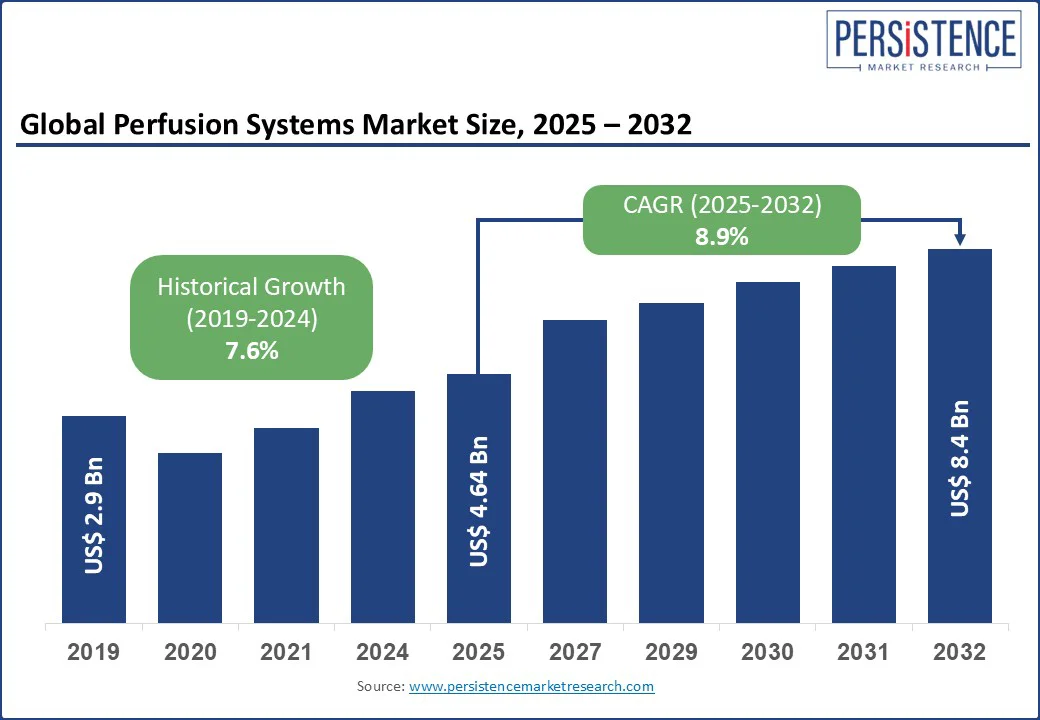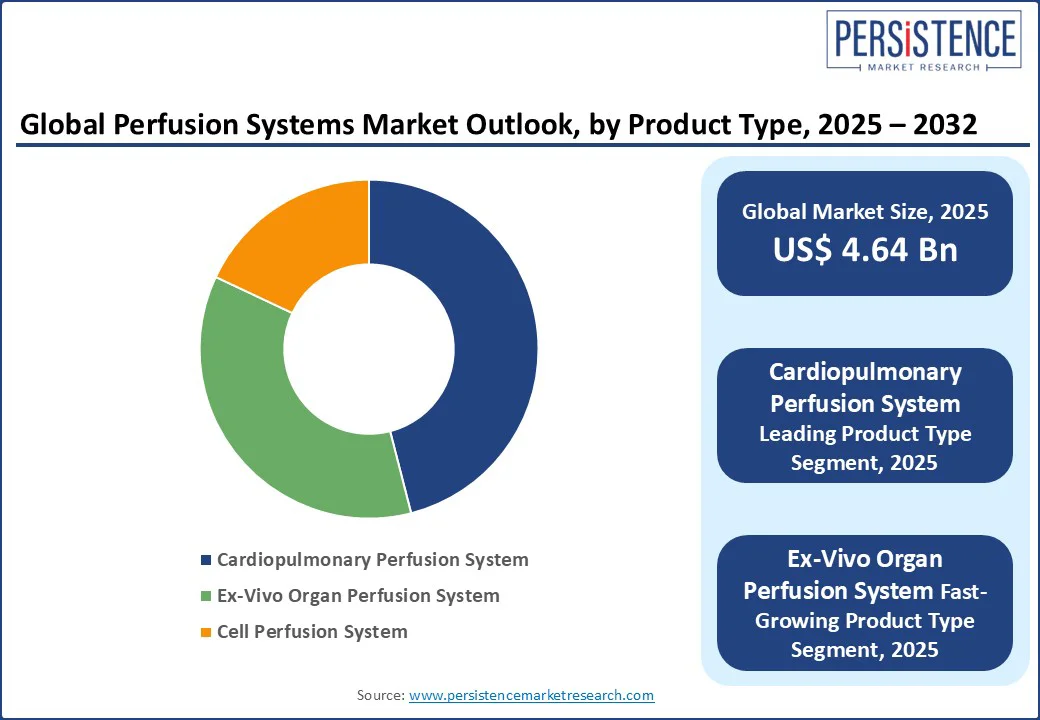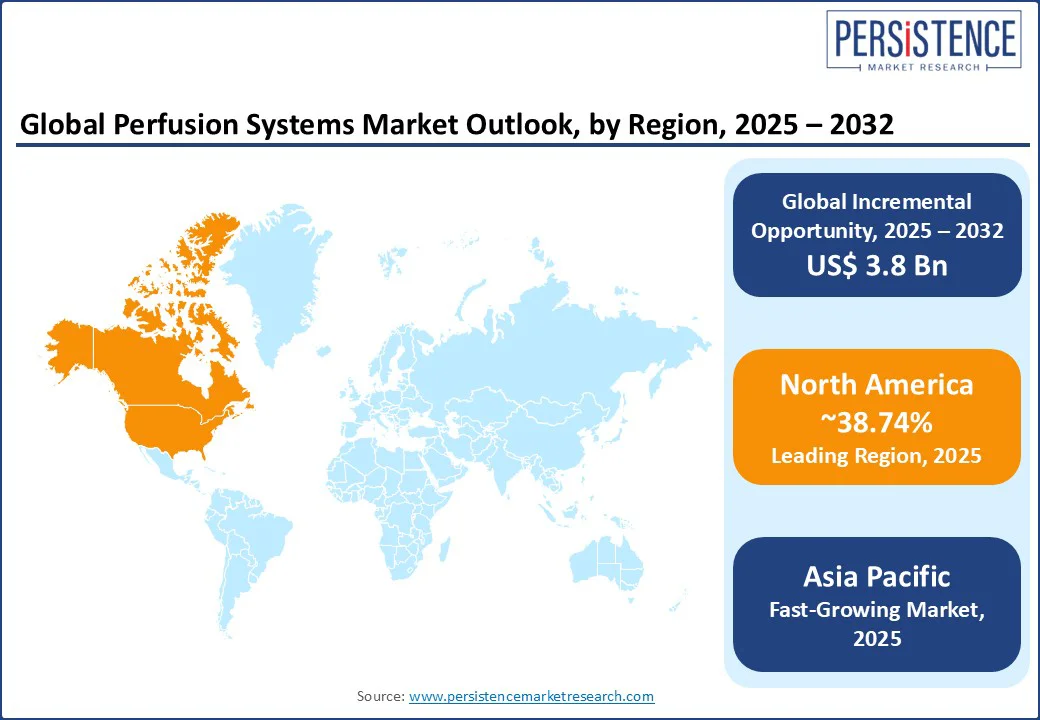ID: PMRREP32140| 183 Pages | 20 Aug 2025 | Format: PDF, Excel, PPT* | Healthcare

The global perfusion systems market size is likely to value US$ 4.64 billion in 2025 and reach US$ 8.4 billion by 2032, growing at a CAGR of 8.9% during the forecast period from 2025 to 2032.
The Perfusion Systems industry is experiencing significant expansion, driven by the rising demand for organ transplantation, increasing prevalence of cardiovascular and respiratory diseases, and technological advancements in perfusion systems.
These systems, critical for maintaining organ viability during transplants and supporting complex surgeries, are gaining traction due to their ability to enhance patient outcomes. The growing adoption of advanced technologies, such as normothermic and hypothermic machine perfusion, along with the expansion of healthcare infrastructure in emerging markets, further fuels market growth.
Key Industry Highlights

Global Market Attribute
|
Key Insights |
Details |
|
Perfusion Systems Market Size (2025E) |
US$4.64 Bn |
|
Market Value Forecast (2032F) |
US$8.4 Bn |
|
Projected Growth (CAGR 2025 to 2032) |
8.9% |
|
Historical Market Growth (CAGR 2019 to 2024) |
7.6% |
The escalating global demand for organ transplantation is a primary driver of the perfusion systems market. With organ shortages persisting worldwide, perfusion systems play a critical role in preserving and assessing donor organs, improving transplant success rates.
According to the Organ Procurement and Transplantation Network (OPTN), over 105,000 individuals were on the U.S. transplant waiting list in 2024, with a new registration every 8 minutes. Globally, according to the Organ Procurement and Transplantation Network (OPTN), which operates under UNOS, organ transplants in the U.S. increased by 5.9% from 2020 to 2021, highlighting the growing need for advanced preservation technologies.
Perfusion systems, particularly normothermic and hypothermic machine perfusion, extend organ viability, enabling the use of marginal or extended-criteria donor organs. In developed markets such as the U.S., the Centers for Medicare & Medicaid Services Organ Transplant Access Model incentivizes hospitals to adopt perfusion technologies, ensuring sustained market growth through 2032.
The high cost of perfusion systems and associated procedures remains a significant barrier, particularly in emerging economies. In countries such as India and Brazil, where healthcare budgets are constrained, these costs deter adoption. For example, a kidney procurement in the U.S. averages US$36,000, with overhead costs adding to the financial burden.
Additionally, maintenance, single-use circuits, and specialized staffing further escalate expenses. In emerging markets, limited reimbursement policies and a lack of universal protocols for perfusion outcomes exacerbate the challenge. These financial constraints, coupled with regulatory complexities, are expected to hinder market penetration in cost-sensitive regions through 2032.
The integration of artificial intelligence (AI) and real-time analytics into perfusion systems presents significant growth opportunities. AI-driven perfusion platforms enhance organ preservation by providing real-time data on parameters such as oxygen consumption, metabolic activity, and hemodynamics, enabling precise viability assessments.
For instance, AI algorithms have reduced liver discard rates by improving decision-making, as demonstrated by leading U.S. transplant centers in 2024. The adoption of portable, AI-powered perfusion systems, such as LivaNova’s Essenz Patient Monitor, allows for dynamic organ monitoring during transport, expanding donor organ eligibility.
In bio manufacturing, AI enhances automation, improving consistency and scalability in cell perfusion processes. Government and private investments, such as the EU’s funding for medical device innovation, support the development of next-gen portable perfusion platforms.
Companies such as XVIVO Perfusion and TransMedics are leveraging AI to innovate, with products such as the XPS with STEEN solution gaining traction in Europe. These advancements align with global healthcare trends toward precision medicine, offering substantial market expansion potential through 2032.

North America remains the leading region, accounting for approximately 40% of the global perfusion systems market share in 2025. The U.S. is a dominant force driven by its advanced healthcare infrastructure, high volumes of organ transplants, and significant industry presence. Over 41,000 organ transplants were performed in the U.S. in 2021, with perfusion systems playing a critical role, according to OPTN data.
Government initiatives, such as organ donation campaigns, and collaborations, such as Medtronic’s partnership with Spectrum Medical for Quantum Perfusion Systems, enhance market growth. Canada also contributes through its robust healthcare system and increasing adoption of advanced perfusion technologies. The region’s focus on innovation, supported by substantial R&D investments, ensures its leadership through 2032.
The Asia Pacific is the fastest-growing market, driven by rising healthcare investments, the increasing prevalence of cardiovascular and respiratory diseases, and growing awareness of organ transplants. China and India lead, with China’s medical device industry benefiting from government funding for healthcare innovation.
The growing incidences of chronic diseases, such as global chronic Hepatitis B infections in the Asia Pacific, fuel demand for liver transplants and perfusion systems. India’s healthcare reforms and Japan’s Asia Health & Wellbeing Initiatives (AHWIN) promote advanced medical technologies, boosting market expansion. The region’s growing population and improving surgical techniques further accelerate demand through 2032.
Europe is the second fastest-growing region, driven by stringent regulatory frameworks, rising health consciousness, and increasing demand for advanced medical devices. Germany, France, and the UK lead, with Germany’s robust healthcare system and R&D investments fostering innovation. The EU’s Medical Device Regulation supports the adoption of perfusion systems, while approvals such as LivaNova’s Essenz system in 2023 enhance market growth.
The rising prevalence of cardiovascular diseases, responsible for 17.9 million deaths annually, drives demand for perfusion systems in surgeries. Europe’s focus on transplant-related research and well-developed healthcare infrastructure ensures steady growth through 2032.

The global perfusion systems market is highly competitive, with key players such as Getinge AB, Medtronic plc, LivaNova PLC, Terumo Corporation, and XVIVO Perfusion AB dominating through innovation and extensive distribution networks. Regional players, such as Organ Assist and Paragonix Technologies, focus on specialized offerings. Companies are investing in AI-driven systems, portable designs, and strategic partnerships to enhance market share, driven by the demand for advanced organ preservation and surgical solutions.
The Perfusion systems market is projected to reach US$ 4.64 Bn in 2025.
Rising demand for organ transplantation and advancements in perfusion technology are the key market drivers of the Perfusion Systems Market.
The Perfusion Systems market is poised to witness a CAGR of 8.9% from 2025 to 2032.
The integration of AI-driven perfusion technologies is a key market opportunity for the Perfusion Systems Market.
Getinge AB, Medtronic plc, LivaNova PLC, Terumo Corporation, and XVIVO Perfusion AB are among the key market players.
|
Report Attribute |
Details |
|
Historical Data/Actuals |
2019 - 2024 |
|
Forecast Period |
2025 - 2032 |
|
Units |
Value: US$ Bn/Mn, Volume: As Applicable |
|
Geographical Coverage |
|
|
Segmental Coverage |
|
|
Competitive Analysis |
|
|
Report Highlights |
|
|
Customization and Pricing |
Available upon request |
By Technology
By Product Type
By End-use
By Region
Delivery Timelines
For more information on this report and its delivery timelines please get in touch with our sales team.
About Author